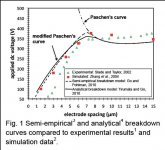1V is used as an example. For the others here is the curve Scott is referring to.
Setup? Details? Yes, offset to either side you get rectification the zoomed in picture looks like back to back diodes on a curve tracer with lots of series resistance.
1V is used as an example. For the others here is the curve Scott is referring to.
What is your ADC linearity through zero? And, size of LSB?
John
DAC, ADC...whatsadifference??
Last edited:
Setup? Details? Yes, offset to either side you get rectification the zoomed in picture looks like back to back diodes on a curve tracer with lots of series resistance.
You know other than using real low signal and a preamp I forget the details and can't look things up at the moment. Server is being worked over!
What is your ADC linearity through zero? And, size of LSB?
John
DAC, ADC...whatsadifference??
Owon Scope following preamp 8 bits real sine waves don't show the notch. Also it differs from the two images shown, which should rule out A/D issues!
But thanks for asking.
Scott just doesn't believe dirt causes loss of signal and when the voltage goes up it jumps back on. So I do have a setup to apply a low voltage sine wave that semi-slowly increases. (Matching preamp to go with it.)
Owon Scope following preamp 8 bits real sine waves don't show the notch. Also it differs from the two images shown, which should rule out A/D issues!
But thanks for asking.
Scott just doesn't believe dirt causes loss of signal and when the voltage goes up it jumps back on. So I do have a setup to apply a low voltage sine wave that semi-slowly increases. (Matching preamp to go with it.)
Can you apply a varying dc?, will the dead remain at zero if most of the sine is one polarity?
Is it dissimilar metals? or "gasp" magnetic domain stuff???
Cheers, John
Owon Scope following preamp 8 bits real sine waves don't show the notch. Also it differs from the two images shown, which should rule out A/D issues!
But thanks for asking.
Scott just doesn't believe dirt causes loss of signal and when the voltage goes up it jumps back on. So I do have a setup to apply a low voltage sine wave that semi-slowly increases. (Matching preamp to go with it.)
There is nothing I know of with a bandgap low enough to do this. That and the fact that these mechanisms have large temperature coefficients makes these plots (stable) very unlikely. When you can I would gladly try and help explain what you are seeing, but I firmly believe you are being fooled by something unrelated. Also as I mentioned read up on Pashen's Law and signals "jumping" small gaps. The breakdown voltage of a 1 micron gap would surprise you.
Keeping "dirt" reliably less than 1 micon average size would be difficult, even so still in large volts regime.
Attachments
Last edited:
Everyone, I am still getting measured difference results between wires with my test set-up. Must be mistakes in the wires, since that is the only thing changed.
Everyone, I am still getting measured difference results between wires with my test set-up.
Time to upgrade, John.
se
Wow, and how do sparkplugs work, Scott?
High voltage arc. Follows Paschen's Law. Important stuff if you're handling multikilovolt signals. You're not doing that, though, are you?
Sure, and I believe that sparkplugs works, even without Paschen's law to verify it. I tend to believe in what works.
I am measuring 5KHz at 30 mV, with signal averaging up to 10,000 times (just for fun).
What timescale does it need for that amount of averaging, is there drift in the AP over that time? that would mess upyour results.
Wrinkle
High voltage arc. Follows Paschen's Law. Important stuff if you're handling multikilovolt signals. You're not doing that, though, are you?
Actually long ago I was in a group working on a semi-high power laser It ran at 22kv 200a around 3 pps. The trigger used a krytron for the first stage switch. I had not only never seen one before, but had never heard of one. Of course that was because they were I think still classified as secret (Lower Level).
So yes during that project I also learned a bit about the breakdown of air. One fellow got his PHD photographing how punch through in air actually happened! Really neat pictures!
I am less worried about air gaps as I am oxide formations on the surfaces of what should be mechanically connected components. How do you make a variable resistor without a wiper and associated problems?
Beats a voltmeter, Steve.
I'm not the one running around telling people I've measured diodes in wires, John.
se
Simon/Scott
I wonder if the picture would be clearer with some dithering? It does look like a 'sticky' A-D issue, but if Simon has excluded it clearly the cause must be elsewhere.
I wonder if the picture would be clearer with some dithering? It does look like a 'sticky' A-D issue, but if Simon has excluded it clearly the cause must be elsewhere.
I'm not the one running around telling people I've measured diodes in wires, John.
se
Steve,
This is getting pretty old. John is talking about measuring distortion in cables, he is no the one who came up with the theory it is caused by diodes. Yes at one time he lent support to the theory, but it ain't his burden.
BREAKING NEWS. I am just now measuring diodes... more next post!
- Status
- Not open for further replies.
- Home
- Member Areas
- The Lounge
- John Curl's Blowtorch preamplifier part II
